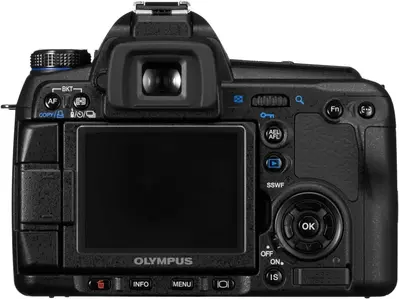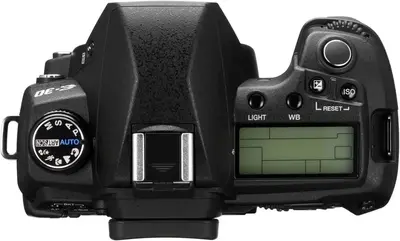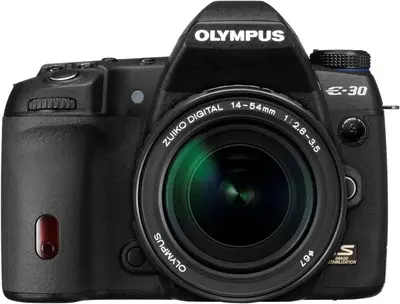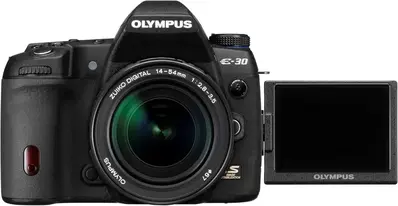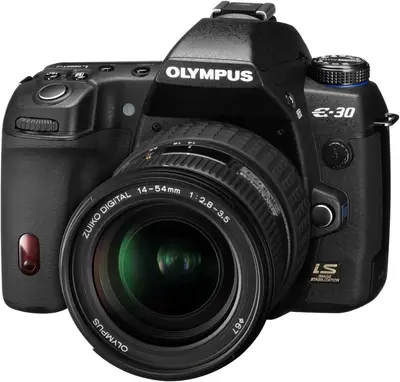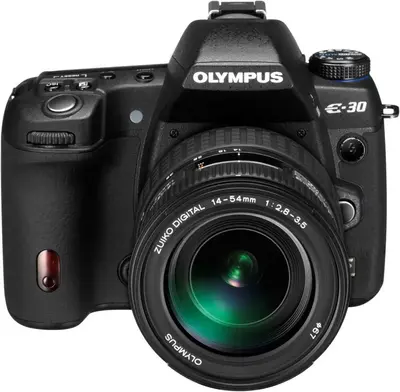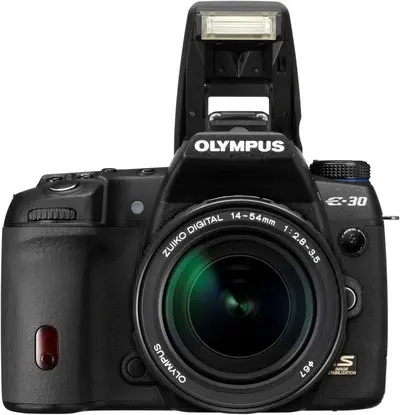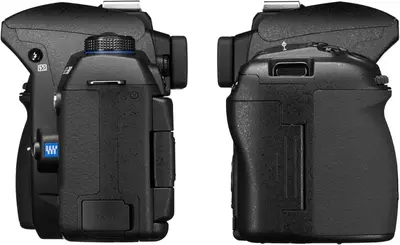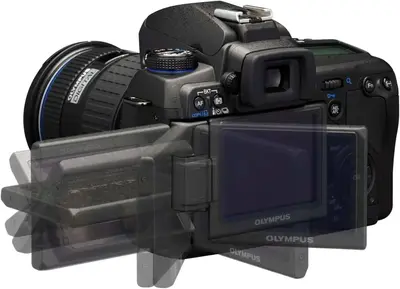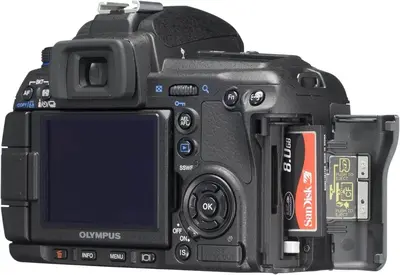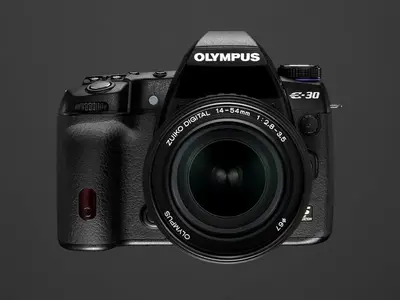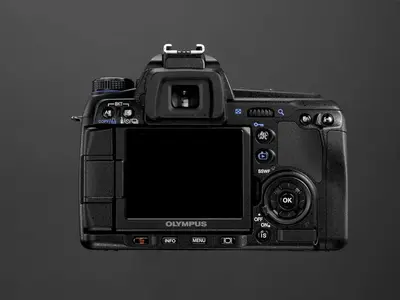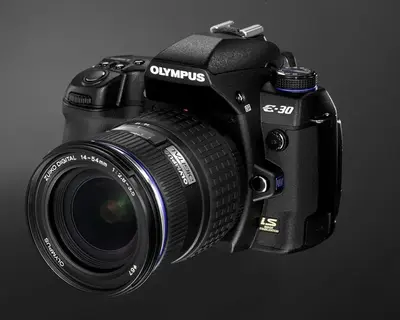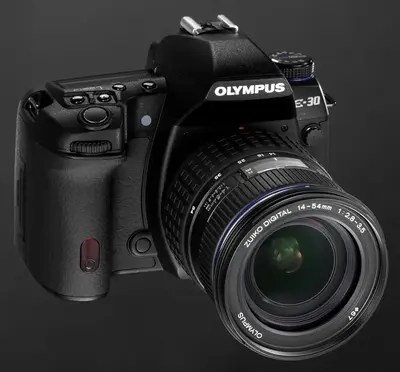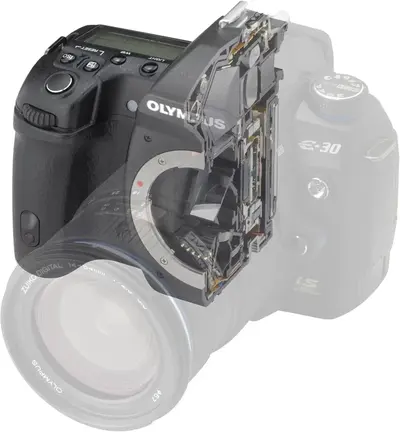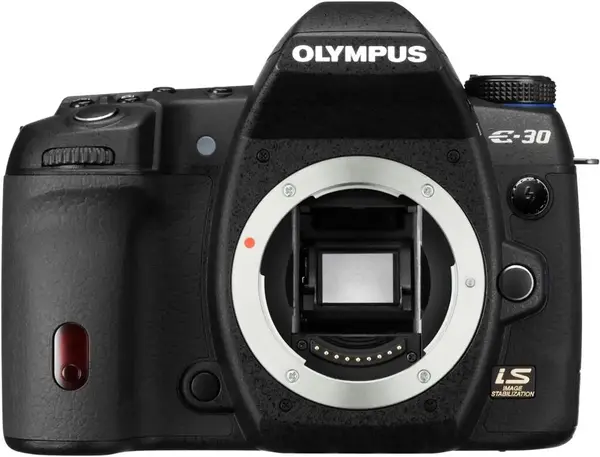
Olympus E30
| Brand | Olympus 2000 |
| Model | E30 Body |
| Released Year | 2000 |
| Type | DSLR Cameras |
| Series | E |
| Color | Black |
| Compatible Mountings | Four Thirds |
| Autofocus | Yes |
| Photo Sensor Resolution | 12 MP |
| Video Resolution | 1080p |
| Optical Zoom | 30 x |
| File Format | JPEG, RAW |
| Status | Discontinued |
Quick view
Overview
The Olympus E-30 is a professional-grade DSLR camera released in 2000, featuring a Four Thirds system sensor that provides excellent image quality and detail. It employs a 8.0-megapixel Live MOS sensor optimized for high-resolution imaging and enhanced low-light performance. The camera includes a built-in stabilization mechanism to reduce camera shake during handheld shooting. Its autofocus system combines contrast-detection with predictive capabilities to improve focus speed and accuracy. The E-30 supports interchangeable lenses compatible with the Four Thirds mount, allowing a broad range of optical options. Additionally, it features a durable metal alloy body construction designed for rugged use and environmental sealing against dust and moisture.
Connectivity options comprise USB 2.0 and video output for easy file transfer and external display compatibility. The camera also supports various exposure modes including manual, aperture priority, shutter priority, and program auto for creative flexibility. The rear LCD is a 2.5-inch color screen facilitating easy image review and menu navigation. Integration with external flash units is available via a standard hot shoe, supporting TTL flash metering. The Olympus E-30 was one of the top models in the Olympus E-series lineup, aimed at serious photographers demanding versatility and reliability in a DSLR format.
Specifications
| Built-In Media | Olympus E-30 12.3 Megapixel Digital SLR Camera |
| Are Batteries Included | No |
| Remote Included | No |
| Global Trade Identification Number | 04545350019266 |
| UPC | 050332166967 |
| Item Height | 4.25 inches |
| Manufacturer | Olympus |
| Screen Size | 2.7 Inches |
| Display Type | LCD |
| Display Fixture Type | Articulating |
| Display Resolution Maximum | 230,000 |
| Has Color Screen | Yes |
| Flash Memory Type | Compact Flash (Type I or II) / xD Picture Card |
| Write Speed | 5 fps |
| Auto Focus Technology | Contrast Detection |
| Focus Features | TTL Phase Difference, Contrast Detect |
| Autofocus Points | 11 |
| Focus Type | automatic with manual |
| Focus Mode | Automatic AF (AF-A) |
| Autofocus | Yes |
| Aspect Ratio | 4:3 |
| File Format | JPEG, RAW |
| Effective Still Resolution | 12.3 |
| JPEG Quality Level | Basic, Fine |
| Bit Depth | 36 Bit |
| Total Still Resolution | 12.3 MP |
| Optical Zoom | 30 x |
| Lens Type | interchangeable |
| Zoom | Optical Zoom |
| Metering Methods | Multi, Center-weighted, Spot |
| Exposure Control | Automatic |
| White Balance Settings | Auto |
| Connectivity Technology | USB |
| Wireless Technology | Yes |
| Total USB 2.0 Ports | 1 |
| Total USB Ports | 1 |
| Total Video Out Ports | 1 |
| Shooting Modes | Automatic |
| Digital-Still | Yes |
| Movie Mode | Yes |
| Image Capture Type | Stills & Video |
| Compatible Mountings | Four Thirds |
| Sensor Type | CMOS |
| Image stabilization | Optical |
| Photo Sensor Resolution | 12 MP |
| Photo Sensor Size | 1.5-inch |
| Maximum Shutter Speed | 1/8000 Seconds |
| Minimum Shutter Speed | 60 seconds |
| Form Factor | Mid-size SLR |
| Special Feature | Image Stabilization |
| Color | Black |
| Item Weight | 1.53 Pounds |
| Video Resolution | 1080p |
| Viewfinder | Optical pentaprism |
| Flash Modes | Automatic, On/Fill, Off, High Speed Sync |
| Camera Flash | no flash |
| Skill Level | Professional |
| Compatible Devices | Computers, Memory Cards (UDMA-Type I, Type II, MicroDrive, xD) |
| Continuous Shooting | 5 |
| Aperture modes | F2.8-F5.6 |
| Viewfinder Magnification | 1.02x |
| Flash Sync Speed | 1/4000_sec |
| Video Capture Format | MOV |
| Battery Weight | 50 Grams |
| Delay between shots | 0.2 seconds |
| Battery Cell Type | Lithium Ion |
| Battery Average Life | 750 Photos |
| Battery Type | Lithium Ion |
| Processor Description | TruePic III+ |
| Water Resistance Level | Not Water Resistant |
| Frame Rate | 30 FPS |
| Camera Type | DSLR |
| Sensor | 8.0 MP Four Thirds Live MOS |
| Lens Mount | Four Thirds |
| Image Stabilization | In-body stabilization |
| Autofocus System | Contrast-detection with predictive autofocus |
| ISO Range | 100-1600 |
| Shutter Speed | 1/8000 to 60 seconds |
| LCD Screen | 2.5-inch TFT color LCD |
| Video Recording | No |
| Storage Media | CompactFlash Type I/II |
| Connectivity | USB 2.0, Video Out |
| Battery | Rechargeable lithium-ion battery |
| Body Construction | Magnesium alloy, weather-sealed |
| Weight | Approx. 845g (body only) |
| Release Date | 2000 |
Images
Key Advantages
The Olympus E-30 offers superior image quality through its 8.0-megapixel Four Thirds sensor optimized for detailed captures. Its advanced autofocus system provides fast and accurate focus tracking for dynamic shooting scenarios. The in-body image stabilization greatly reduces blur from hand movement, enhancing sharpness in low light. Compatibility with a wide range of Four Thirds lenses allows professional-level optical flexibility. The rugged and weather-sealed construction ensures durability and reliability in challenging environments. Additionally, the camera’s comprehensive exposure controls enable precise creative adjustments suitable for advanced users.
Limitations
The E-30’s 8.0-megapixel sensor, while high quality for its time, is modest compared to modern DSLR resolutions, limiting very large print sizes. Its ISO range is restricted relative to contemporary models, impacting performance in extremely low-light conditions. The camera’s autofocus system, though advanced at launch, can be slower compared to newer technologies like phase-detection autofocus. Video recording capabilities are either limited or absent, as this DSLR predates comprehensive video functions. The rear LCD screen, at 2.5 inches, lacks the higher resolution and touch functionality common in current DSLRs. Battery life, while adequate, falls short of more recent models optimized for extended shooting sessions.
FAQ
What type of sensor does the Olympus E-30 use?
The Olympus E-30 uses an 8.0-megapixel Four Thirds Live MOS sensor, which balances image quality and size for DSLR photography.
Is the Olympus E-30 compatible with modern lenses?
The E-30 is compatible with Four Thirds mount lenses; however, it is not natively compatible with Micro Four Thirds lenses without an adapter.
Does the Olympus E-30 have image stabilization?
Yes, the Olympus E-30 features in-body image stabilization that helps reduce camera shake during handheld shooting.
Can the Olympus E-30 record video?
No, the Olympus E-30 DSLR does not support video recording as it was primarily designed as a still photography camera.
What kind of autofocus system is on the Olympus E-30?
It features a contrast-detection autofocus system enhanced with predictive algorithms to improve focus accuracy and speed.
Is the Olympus E-30 designed for weather resistance?
Yes, it has a rugged, weather-sealed metal alloy body designed to protect internal components from dust and moisture.
Does the Olympus E-30 have a built-in flash?
No, the Olympus E-30 does not include a built-in flash but supports external flash units via a hot shoe with TTL metering.
Disclaimer
The content on is provided for general informational purposes only. We do not guarantee the accuracy, completeness, or reliability of any information, specifications, or visuals presented on the site.
is not responsible for any content, images, or data uploaded or shared by users. Users are solely responsible for the content they submit.
We may include links to third-party websites for convenience. We do not endorse or take responsibility for the content or policies of any external sites.
Use of the site is at your own risk. Always verify critical information independently before making decisions based on content from this website.

